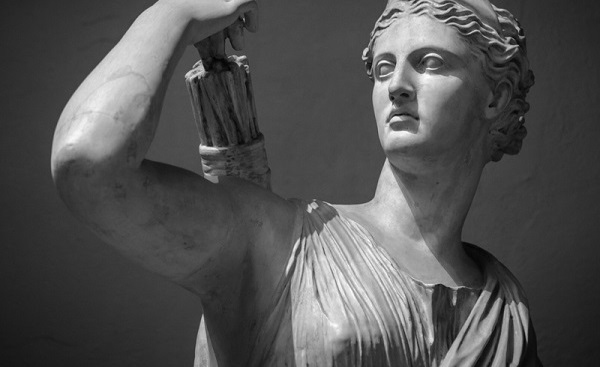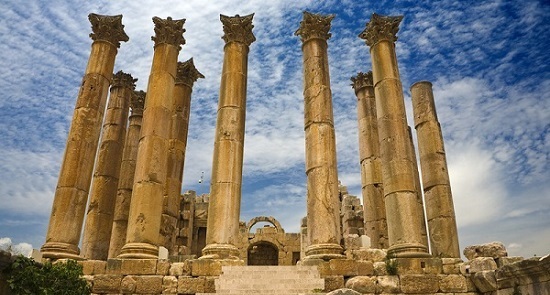

Artemis is the goddess of the hunt, wilderness, childbirth, virginity and protector of young girls in ancient Greek mythology. She is often depicted as a maiden with a bow and arrows and is associated with the crescent moon. She was considered to be one of the most powerful and independent Olympian goddesses. Artemis was also considered to be a protector of the wild and was often invoked for protection during childbirth.

The etymology of the name Artemis is not entirely clear, but it is believed to have originated from the ancient Greek word "Artemis," meaning "safe" or "unharmed." It is also thought to be related to the word "artamos," which means "butcher" or "killer,". The name Artemis is also associated with the ancient Anatolian goddess of fertility and wild animals, known as "Artemis of Ephesus" in the ancient city of Ephesus. She was considered to be the protector of young girls, and her temple was one of the Seven Wonders of the Ancient World. The goddess Artemis is a compound of two words "Ar" which means "she" and "Temis" which means "to cut". Her name then means "She who cuts" which could relate to the hunting aspect of the goddess.
Artemis was one of the twelve Olympian gods and goddesses in Greek mythology and was the daughter of Zeus and Leto. She was known for her beauty and was often depicted as a wild, independent, and fierce figure. Artemis was also known for her role as a protector of young girls. She was widely worshipped in ancient Greece, particularly in the city of Ephesus, where her temple was one of the Seven Wonders of the Ancient World.

Jordan. Jerash (the Roman ancient city of Geraza). Corinthian columns of the Temple of Artemis
In Greek mythology, Artemis was known for her many roles and attributes. Artemis was fiercely independent and was often depicted as a wild and powerful figure. She was a virgin goddess and was closely associated with maidenhood and childbirth. She was also known for her role as protector of the wilderness and wildlife.
In ancient Greece, Artemis was widely worshipped and had many devotees. Her cult was particularly strong in the city of Ephesus, where her temple was one of the Seven Wonders of the Ancient World. She was also widely worshipped in other cities such as Brauron, Delos, and Delphi. Artemis was typically worshipped in the form of statues and sculptures, which were usually made of marble or bronze. Her temples and shrines were also adorned with images of her and other symbols associated with her.
She is also commonly depicted in hunting attire, with a hunting bow and arrows, as she is the goddess of hunting. Artemis is often shown with wild animals such as deer, lions, and bears, which symbolise her association with wilderness and wild animals. Artemis was often depicted in ancient Greek art, including pottery, sculpture, and frescoes. She was typically depicted in a variety of settings, such as in the wilderness, hunting, and at her temple. She was also depicted in relation to other figures such as Apollo, her twin brother, and other Olympian gods and goddesses. She is also represented in Roman art, as the Roman goddess Diana.
The legacy of Artemis can be seen in various aspects of culture and society. In literature, Artemis is a popular figure in ancient Greek myths and stories. She is also featured in many works of art, including sculptures, paintings, and frescoes. Her name and attributes have been used in various scientific, cultural and sports references, such as the name of NASA's lunar exploration program, called "Project Artemis", or the name of a car brand, or even a running event, "Artemis Women's Race".
In modern times, she continues to be a popular figure in literature and art, and her legacy can also be seen in the environmental and feminist movements, where her association with wilderness and the protection of young girls is often invoked. Artemis' legacy can also be found in many places around the world that bear her name, such as the town of Artemis in Greece, or the Artemis Temple in Turkey, which is a UNESCO World Heritage Site.
Artemis is a significant figure in Greek mythology, known for her many roles and attributes. Artemis continues to be a popular figure in literature, art, and culture, and her legacy can be seen in various aspects of society. She is an embodiment of power, independence, protection, fertility and virginity. Her legacy continues to inspire people today, in fields such as science, culture, sports and many more.
Q1. What was the significance of the temple of Artemis in Ephesus?
Ans. The temple of Artemis in Ephesus was one of the Seven Wonders of the Ancient World and was considered one of the most important religious sites in ancient Greece. It was dedicated to the worship of Artemis and was a major centre of pilgrimage.
Q2. Who were the followers of Artemis?
Ans. Artemis was especially revered by young girls and women, other followers included hunters and wilderness dwellers. She was also invoked in childbirth and her cult was also associated with virginity and maidenhood.
Q3. How is Artemis represented in Roman mythology?
Ans. In Roman mythology, Artemis is known as Diana and has similar attributes and roles as the Greek goddess Artemis. She is the goddess of the hunt, virginity, and protector of young girls.